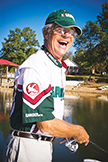
Summer Night Fishing
Fishin’ with Capt. Gus
Capt. Gus Gustafson is an outdoor columnist and
a full-time professional fishing guide.
Visit www.FishingWithGus.com or call 704-617-6812 for more information or to book a trip.

CAPT. GUS GUSTAFSON
It seems we’re having more than our share of sunny days, higher water temperatures and lots of pleasure boats on the lakes. Of course these conditions influence fish to move to deeper water during the day where it’s not only cooler, but the environment is less stressful. But when dusk arrives, the fish return to their shallow water haunts and spend the night feasting on hapless schools of baitfish that swim near the surface.
While not everyone enjoys fishing in the dark, it’s a well-known fact that some of the biggest bass, catfish and stripers are taken between dusk and dawn each summer. While there’s no doubt that fishing is more difficult at night, the rewards are great.
Anglers new to night fishing should be aware that plying the waters of a large impoundment and fishing in the dark is not without challenges. Not only is it harder to navigate and see, but casting, fighting and netting a fish at night requires more skill than during the day. Simple tasks, like tying knots or unhooking fish become chores if you’re not prepared. With that in mind, here are a few thoughts that might help prepare you and make your next night fishing trip a little more successful.
First and foremost, wear a PFD while running from spot to spot, and leave it on while fishing. Organize your boat and fishing gear before you leave the dock. Pre-rig as many fishing outfits as possible, and have the terminal tackle you plan to use in a designated tackle box. Clear the decks of anything that might cause one to trip or fall. Be certain that everything has a place, and that there is a place for everything, including dock and anchor lines.
Decide in advance where you want to fish. Check out unfamiliar waters during the day. Identify them with landmarks visible at night, and mark each spot on a map or chart. Better yet, if you have a GPS, waypoint the spots and follow your trail back to port at the end of the trip.
Lighting is the number one issue at night. Above all else, assure that the boat’s navigation lights are operating. Be sure that boat batteries are fully charged, and keep an extra-long set of jumper cables onboard for emergencies. Flashlights, headlamps, spotlights and lanterns are a necessity, as are the replacement bulbs and batteries to keep them working.
Playing a fish in total darkness requires skill and a bit of luck. But the key to bringing a big fish to the net is to keep a tight line and a drag set loose enough to allow the fish to run when it wishes. It’s difficult enough to see a fish in water during the day, but at night it’s almost impossible. To make netting easier,
tape a flashlight to the handle
of your net and turn it on when the fish is close.
Fish also have difficulty seeing in low light conditions, so use baits that give off a scent and/or make some type of noise to draw attention. That is why scented soft plastics and lures that pop, buzz or rattle are effective after dark.
Lighted boat docks are preferred places to fish at night. The biggest fish come from those with very bright lights that shine directly into the water. Keep in mind that not all lighted docks are equal. The best ones are located near deep water and have some sort of woody debris or fish attractors planted in the water underneath.
Lighted docks should be approached quietly, and care should be taken not to throw a shadow over the lighted area. Other popular haunts for night time fishing are “fall downs” (trees lying in the water), bridges, rip-rap points, launch ramps and commercial boat docks.
Give summer night fishing a try. There are plenty of fish to be caught!

The Dorcy LED Waterproof Floating Flashlight. Night Fishing? You might need one of these. www.Dorcy.com.
ABOUT PILOT MEDIA
Copyright © 2018 Pilot Media II LLC

